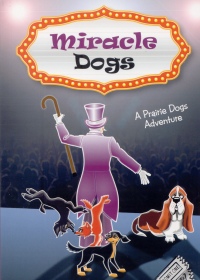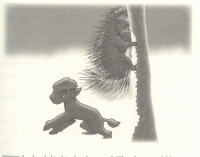| ________________
CM . . .
. Volume XIX Number 16. . . .December 21, 2012
excerpt:
Miracle Dogs is the third in the series following The Prairie Dogs (Vol. XI, No.13, March 4, 2005 ) and City Dogs (Vol. XIV, No. 3, Sept. 28, 2007). Pierre is still the leader, and now the dogs live with Mr. Abram, but they are worried that their good life wonít last. In this story, Pierre and Dare have two puppies who get into no end of trouble. The parents, wanting their puppies to have a good home, see that one solution is to have them trained as assistance dogs. The puppies just want adventure and fall into the hands (or paws) of the dreaded cats.
The story continues the development of the characters of the animals and their humans in a realistic way. Although the animals talk, the relationship with the people is parallel to what would logically happen. The vocabulary is excellent for the intended readers. Sentences are varied and would appeal to older readers. Younger readers would enjoy the story and the adventures of the animals. The plot is divided into 16 chapters with titles which preview the action. The humour is enjoyable, particularly in the museum where the dogs encounter items they havenít seen before. Black and white drawings add both to the plot and humour of the story. Miracle Dogs is a delightful read. Although it could stand alone, the continuation of the characters and plot make this an interesting trilogy. The dogs encounter animals that they met in the previous books. Local Saskatchewan colour is evident as the dogs perform at Telemiracle, an annual telethon sponsored by the Kinsmen. Miracle Dogs can certainly be enjoyed by all ages, and readers of animal stories, realistic fiction and adventure will not be disappointed. Highly Recommended. Deborah Mervold, an educator and teacher-librarian from Shellbrook, SK, is presently employed by Saskatchewan Institute of Applied Science and Technology (SIAST) in the areas of faculty training and program development.
To comment
on this title or this review, send mail to cm@umanitoba.ca.
Copyright © the Manitoba Library Association. Reproduction for personal
use is permitted only if this copyright notice is maintained. Any
other reproduction is prohibited without permission.
NEXT REVIEW |
TABLE OF CONTENTS FOR THIS ISSUE
- December 21, 2012
AUTHORS |
TITLES |
MEDIA REVIEWS |
PROFILES |
BACK ISSUES |
SEARCH |
CMARCHIVE |
HOME |

 Pierre, the champion agility miniature poodle from Montreal, Dare, the terrier, Old Sam, the basset hound, Mouse, the Chihuahua, and Mew, half beagle who sometimes thought she was a cat, have to rescue the puppies by finding a good home for one of the kittens who is deaf. Their adventures lead them to destroy a kitchen, explore an old museum, and make their way into the heart of Colleen Calloway, a woman in a wheelchair who thinks she doesnít like animals. The animals must work together as a team and hope for a miracle to return safely home.
Pierre, the champion agility miniature poodle from Montreal, Dare, the terrier, Old Sam, the basset hound, Mouse, the Chihuahua, and Mew, half beagle who sometimes thought she was a cat, have to rescue the puppies by finding a good home for one of the kittens who is deaf. Their adventures lead them to destroy a kitchen, explore an old museum, and make their way into the heart of Colleen Calloway, a woman in a wheelchair who thinks she doesnít like animals. The animals must work together as a team and hope for a miracle to return safely home.